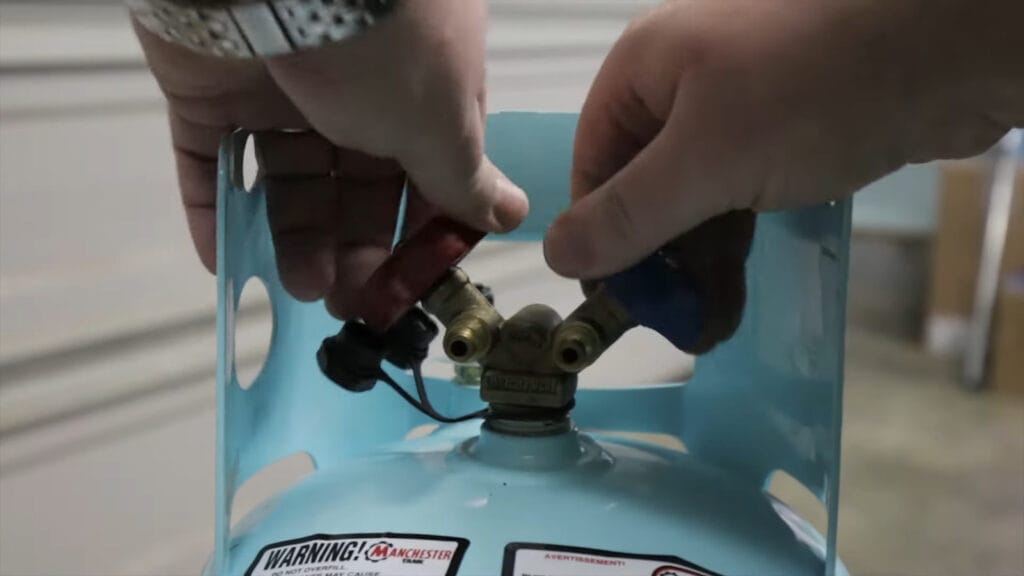Does Evacuating AC Remove Oil?
Evacuation doesn’t remove AC oil; its goal is to remove any moisture and non-condensable gases from the system using a vacuum pump. AC oil removal or replacement is not typically involved in this process.
However, as this process involves sucking out, it may suck out a small amount of oil, but the amount needed to lubricate the moving parts of the compressor will always remain intact in the system.
Are you curious how an AC evacuation takes place?
Then sit back, and let’s get to the bottom of what AC evacuation is, whether it removes oil or not, and if not, then how can you remove AC oil, and so on.
What is Car AC Evacuating?
AC evacuation is a routine maintenance procedure that removes air and moisture from the AC system. It’s a way to love and treat your AC system to prevent damage (leaks or damage to the compressor) and make it ready to blow out cold, fresh air on hot summer days.
During this process, all the old refrigerant ( air and moisture) will be removed from the system and ready for a fresh refrigerant refill. And to do this, you will need a vacuum pump to create a vacuum in the system, which sucks moisture or air or similar contaminants that may be present there.
When to Evacuate the AC System
Just for not knowing when the AC system demands evacuation, we think of evacuating even when it’s unnecessary or not the right solution for our problem.
So, when to evacuate the AC system?
Usually, we need to evacuate the AC for cleaning, repairing, or replacing specific components. For example, when the AC system is exposed to air for a long time or gets contaminated, it needs proper cleaning. At this time, evacuation is the solution.
Let’s know a few more common scenarios.
- A long time has passed, and you need to replace the refrigerant
- Whenever any AC system component requires repair or replacement
(condenser coil or compressor failure). - If you are facing blowing hot air from the AC system or noticeable icing at low temp.
- When the AC system is eating up more power than it needs.
How to Evacuate Car AC
To keep your car’s air conditioning system in tip-top condition, evacuating is necessary. Happily, this auto-caring process is easier than you might think. If you are confident with DIY, you can surely go for it.
Let’s know the exhaustive step-by-step guide.
What Equipment You Will Need
- PPE ( safety shoes, goggles, gloves, etc.)
- Manifold gauges
- An extra yellow connector,
- A vacuum pump,
- A recovery tank,
- An AC recovery unit
Step One

Empty the recovery tank filled with nitrogen gas for storage and shipping concerns. It’s not difficult to do; loosen the blue and red valve head knobs and release the gas into the air without worrying because nitrogen gas is safe for nature.
Once all the gas has been safely released, securely tighten the valve head knobs.
Step Two
Attach the vacuum pump to the blue valve port, activate the vacuum port, and then open the blue valve once more. Let the deep vacuum process run for about an hour; meanwhile, it will extract all the air and moisture available in the recovery tank. When done, tighten the blue valve and turn off the vacuum pump.
Step Three
It’s time to hook up the manifold gauges ( red, blue & yellow). Connect the red manifold gauge on the high-pressure port and the blue on the low pressure port. Now, link the yellow manifold gauge with the recovery unit’s corresponding port (there are two ports in the recovery unit).
Step Four
It’s time to use the extra yellow connector; attach one end to the recovery machine’s blue side and the other to the recovery unit outlet side. Slowly loosen the blue valve of the recovery tank and check if there is any leak in the system.
Step Five
Now, we will proceed to the final evacuation process.
Open the blue liquid valve on the manifold gauges and the outlet valve of the recovery tank. Now, you are ready to press the power button on the machine. Next, loosen the inlet valve of the recovery unit and wait until it makes a knocking sound. When you hear the knocking sound, slowly tighten the inlet valve until the knocking sound stops.
Step Six
Open the manifold gauge red vapor valve and wait until both the gauges read zero. It’ll take about 30-45 minutes to remove all the refrigerant.
Once finished, close both the blue and red sides of the manifold gauges. Therefore, first close the inlet valve of the recovery unit and then the outlet valve.
Step Seven
Finally, turn off the recovery unit and immediately tighten the blue valve of the recovery tank. Then, remove the connection between all the lines one by one. Disconnect the high-pressure and low-pressure manifold gauges and the yellow connector from the recovery unit and tank, and it’s done.
Don’t forget to put back the Dust caps of your car’s valve protector.
Could Evacuating AC Lead to a Need for Extra Oil?
Oil circulates within the AC system and the refrigerant, ensuring critical components stay properly lubricated. So, having the right amount of AC oil is important to maintain the optimal performance and efficiency of your AC system. It should neither be less nor more than the required amount.
Evacuation removes any moisture or air that may have entered the system, creating a vacuum and leaving the oil behind. At the same time, it’s also possible that a small amount of oil may be lost during the evacuation process. So, many of us are concerned and ask, “Could Evacuating AC Lead to a Need for Extra Oil?”
Usually, evacuating AC doesn’t lead to a need for extra oil. The loss of oil during evacuation is usually negligible; it can typically be replenished without the need for additional oil. But if you feel the need or notice low oil symptoms, it’s better to consult with a professional.
How Can You Remove Car AC Oil?
You have only one option to remove car AC oil: flushing the AC system. Flushing will remove all the oil and liquid refrigerant present in the AC system, and be ready to recharge your AC system with new oil.
Flushing the AC system is not so easy, like filling it with oil, but not so difficult either. If you are a DIY lover, you can surely go for it. If you are a new timer, it may take a few hours, but it’s not a work of more than an hour.
What You Will Need
Just a few components like:
- Air Compressor
- Flushing Gun
- Flushing Solvent
- Heater Hose,
Cautions
- To flush your AC system, park your car in a well-ventilated area,
- Give the engine enough time to cool down; you can’t flush the AC system when the engine is hot.
- Avoid taking the flushing solvent-filled guns near the battery or any positive lines.
Flushing The AC System
You can’t flush the entire system; you must flush the hard AC component (condenser, evaporator, liquid line) separately and avoid the systematic parts like the AC compressor, drier, valve, etc., or the heat exchanger.
Evaporator
Remove the expansion valve and POA valve from the evaporator coil. Disconnect the outlet port and insert one end of the heater hose in it and the other end in a bucket outside or underneath the car. Wait a few minutes, and then open the evaporator inlet port.
Attach the solvent-filled flush gun with the air compressor and put the gun nozzle in the inlet port. Press the trigger and flush the evaporator. Lots of oil and refrigerant are in the evaporator, so it may take a few rounds of flushing. Usually, I do three flushing. Once flushing is done, use a microfiber rag to wipe down the evaporator.
Condenser
The flushing process is the same for the condenser as well. Refill the flushing gun and flush the condenser following the same procedure as the evaporator.
Liquid line
Remove the liquid line using an adjustable wrench. Hold the liquid line upright in the bucket, and put the flush gun nozzle in the liquid line through its upper end. Press the trigger for 30-40 seconds, and flushing the liquid line is done. Drain the line completely, wipe down the liquid line with a microfiber rag, and reinstall it in the system.
Hoses
As everything passes in the system through the hoses, some old oil and refrigerant can also be there. So, you should flush these as well. Flushing the hoses is the same as the liquid line. Remove them from the system and follow the other steps we did for flushing the liquid line. Then, reinstall them from where they came from.
Frequently Asked Question
Does pulling a vacuum on AC remove oil?
Yes, pulling a vacuum on the AC removes oil, but the amount is very low and doesn’t affect the overall performance of the AC system. A vacuum is designed to suck out moisture and contaminants, not the liquid oil. Still, it may drain a small amount of oil during the process.
How do you remove excess oil from air conditioner?
To remove excess oil from an air conditioner, first, you have to locate the place where the excess oil comes from, either from the compressor, evaporator, or the dryer. Then, flush the components separately with a flushing solvent and drain the excess oil. Follow the AC oil removal process I just shared above.
Does AC run off oil?
Yes, the AC runs off oil. Oil lubricates the AC system parts and ensures they work efficiently and smoothly. Due to the unavailability of enough oil level in the system, its parts, especially the compressor, will get damaged and fail to work.
Do you need to add oil after vacuuming AC system?
If you are just vacuuming the AC system and not installing a new compressor or any other part, you don’t need to add refrigerant oil. It just removes non condensable gases and moisture from the system.
It also sucks some oil, but not that much that the refrigeration system will fail to operate. You can add a little pag or mineral oil if you want, but typically it’s not needed.
Verdict
I have delved into “Does Evacuating AC Remove Oil’. While evacuating AC removes some oil, the quantity needed to operate the system will remain. So, if you wish to drain the system completely, AC flushing is recommended. I’ve shared both the evacuation and flushing process in detail above; follow according to your needs.
Finally, if you’re unsure whether your AC system needs an evacuation or flushing (though I have explained when you need evacuation and when flushing), it’s always best to consult a professional who can assess your situation. Don’t hesitate to ask any further questions about auto repair and maintenance; I am always here to assist you.






